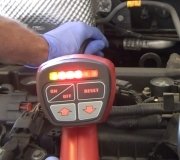I can add a few comments of value until KASEKENNY1 sees your update.
Start by looking for AC components that are stained with oil. That will be a likely spot to find a leak. Common places are at the ends of rubber hoses where the aluminum fittings are crimped on, along the rubber hoses, and along the bottom of the condenser in front of the radiator, especially in the two lower corners. A measured amount of special refrigerant-compatible oil circulates inside the AC system. Most of the time when there is a leak, some of that oil seeps out too at that spot.
A corroded and leaking condenser is a good suspect when the refrigerant leaks out in about two days. Leaking hoses take a lot longer at first, but those leaks gets worse over time.
AC system specialists will start by performing a leak test with an electronic leak detector, but those still require the leak to be of a pretty good size. When it is smaller and takes weeks or months to loose the charge, they will usually inject some refrigerant with a leak-detection dye. Many shops will automatically add that dye any time they recharge or repair a system. When they do, you will usually find a bright green or bright yellow sticker under the hood in an easily-seen area. To find those small, elusive leaks, you search with a black light. The dye will show up as a bright yellow stain. When you find that, you will usually see some oil residue there too.
You can also buy a do-it-yourselfer recharge kit with the dye already in it. Many auto parts stores rent or borrow tools. Those that do will usually have a black light. In my city they make you buy the tool, then you get a full refund when you take it back. If you should decide to keep a tool, you still take it back, then they order or give you a brand new one.
When using an electronic leak detector or when searching for the dye, an often-overlooked item is the 4"-long rubber hose hanging down on the passenger side of the firewall, under the hood. You may need to shine the black light up on it from under the car. That is the drain tube for the water that condenses on the evaporator inside the dash. If that evaporator is leaking, the dye will run into the drain pan along with the condensed moisture, and out that drain tube. You'll see the bright yellow stain inside that rubber tube.
Here's links to some related articles that will be helpful:
https://www.2carpros.com/articles/air-conditioner-how-to-add-freon
https://www.2carpros.com/articles/air-conditioner-leak-detection
As long as there's a little refrigerant in the system, you can add more, but keep in mind too much is far worse than too little. When the charge gets low enough for the system pressure to drop to a certain point, the compressor will be disabled and will not run. That is done because with the system that low on charge, it could be possible for the low side to get pumped into a vacuum. That could allow outside air to be drawn in along with the humidity in it. Moisture combines with refrigerant to form an acid that will attack the metal parts in the system, resulting in a bunch of leaks.
If the system is totally empty, or if it has been opened for some other repair, there is going to be air in it that has to be removed before refrigerant is pumped in. That is done with a vacuum pump, typically for a minimum of 20 minutes, although most specialists prefer a half hour to an hour. Under a near-perfect vacuum, water boils at 77 degrees, making it a vapor that's easy to pump out. While we don't feel comfortable admitting it, as long as there is still a little pressure in the system, there should be no air or moisture in it, so simply adding one can of refrigerant should be okay.
This is definitely not a case where "more is better". You'll find a sticker under the hood that lists the number of ounces of refrigerant your vehicle uses. Most of the time it lists two amounts, one with rear AC and one without. If you think you will add extra so it will hold out during your upcoming trip, you are more likely to do more damage. Those amounts are dictated to cause the evaporator to be nearly exactly half full with liquid and half with vapor. That point where it changes state is where it gets real cold. With too little refrigerant in the system, it will be turning to a vapor too soon, in the hose coming in from the condenser, so the cooling will take place under the hood. With too much refrigerant, it will turn to a vapor in the hose going back out to the compressor, so again, the cooling takes place under the hood. What is more serious is that liquid could slosh into the compressor and destroy it. Compressors can only compress a vapor. At a minimum they will lock up and shred the belt if liquid gets into the cylinders, and more likely the pistons or connecting rods will be damaged, then you'll need a new compressor. Rather than adding extra, it's safer to add just enough to get the system working, then, do that again a few days later if necessary. At least that will get you through your vacation, then you can get a proper diagnosis and repair later.
Wednesday, August 5th, 2020 AT 5:52 PM




